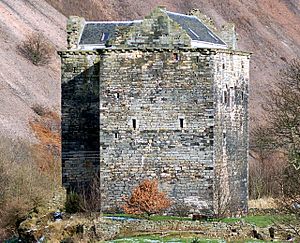Marie Pieris facts for kids
Marie Pieris, Lady Seton (born around 1520, died 1576) was a French noblewoman who served at the Scottish royal court. She was the daughter of René Pierres and Antoinette d'Hommes. Her family, the Pierres, believed they were related to the Percy family from England.
Contents
Life in Scotland

Marie Pieris came to Scotland as part of the household of Mary of Guise. Mary of Guise was the wife of King James V. Soon after arriving in Scotland, Marie married George Seton, 6th Lord Seton. Their marriage ceremony, called a handfasting, took place at Falkland Palace in February 1539. Marie's father wrote to Mary of Guise, thanking her for arranging the marriage. He promised that Marie would receive her inheritance from him after his death.
In those times, married women in Scotland usually kept their own family names. Marie and Lord Seton had several children. Their most famous child was Mary Seton, who became a close friend and companion to Mary, Queen of Scots.
Another lady from the queen's household, Jeanne Delareynveil, married Robert Beaton in 1539. Their daughter, Mary Beaton, was also one of the famous group known as the four Marys. These four young women were all companions to Mary, Queen of Scots.
Scotland at War
After King James V died, Scotland was ruled by James Hamilton, 2nd Earl of Arran, who was known as "Regent Arran." The young Queen Mary was still a baby and was cared for by her mother, Mary of Guise. First, they lived at Linlithgow Palace, then at Stirling Castle.
The King of England, Henry VIII, wanted Queen Mary to marry his son, Prince Edward. This idea led to a war between Scotland and England, which is often called the Rough Wooing.
Marie Pieris wrote a letter to Mary of Guise from Niddry Castle. In her letter, she warned the queen's mother that Lord Seton had heard about a plan by Regent Arran to kidnap the young Queen Mary. Marie signed this letter "Marye Pyerres."
In June 1548, Marie and Lord Seton were given new land at Winchburgh and "West" Niddry Castle. During the siege of Haddington, the family lived safely in Culross in Fife. Lord Seton passed away in July 1549 and was buried in Culross. After the war ended, Marie Pieris had his body moved and reburied at Seton Collegiate Church, next to his father.
The Seton family and the Hamilton family became friends again in August 1550. Marie's step-son, George Seton, 7th Lord Seton, married Isobel Hamilton. Her father, William Hamilton, was in charge of Edinburgh Castle for Regent Arran. Their wedding was a big celebration at Edinburgh Castle on August 12.
Second Marriage
In 1554, Lady Seton married Philippe Pierre de Cluys. He was also known as "Pierre de Clovis." Philippe had come to Scotland with a letter about Mary, Queen of Scots' French household. He was the nephew of Jacques de la Brosse, a French diplomat and soldier. Marie and Philippe did not have any children together. Marie Pieris was sometimes called "Madame Briant," but she also continued to use her title "Lady Seton."
Serving Mary, Queen of Scots
When Mary, Queen of Scots returned to Scotland in 1561 after her husband died, Marie Pieris joined her royal household. Marie often helped the queen with sewing. For example, in January 1564, she was given special linen to make sleeves for the queen or her ladies.
Mary, Queen of Scots gave gifts to "Ladie Seitoun," including silk fabric in November 1561. In 1565, Queen Mary officially granted something to "Dame Marie Pier, Lady Seytoun and Brieane." Mary also gave "Madame Briant" a hat in March 1565.
In May 1566, when Queen Mary was expecting a baby, she made a will. She planned to give her jewels to different people if she died. "Madame de Briante" would have received a pair of bracelets with purple stones called amethysts.
At Easter in 1567, Marie Pieris was part of a special ceremony. Queen Mary washed the feet of her ladies, including "Madame de Briande." This was a tradition called Maundy Thursday.
After the death of Lord Darnley, Queen Mary's husband, a servant named "French Paris" came to the queen's room. He was there to hang black cloth around her bed for mourning. "Madame de Bryant" gave him a fried egg for his breakfast. He saw her talking privately with the Earl of Bothwell.
In 1567, Mary, Queen of Scots was removed from her throne. She was taken to Lochleven Castle. She later escaped and first found safety at Niddry Castle. In 1568, she went to England, and Marie's daughter, Mary Seton, joined her there.
In August 1570, Marie Pieris was at Blair Castle and heard that her daughter was unwell in England. She wrote to Queen Mary, asking if her daughter could come home. The messenger carrying these letters was caught. On August 29, "dame Marie Pier" and her son Robert were arrested. They were accused of sending letters to Queen Mary that questioned the authority of the new King, James VI of Scotland. They were released after promising not to write to Queen Mary again.
During the "lang siege" of Edinburgh Castle, Marie Pieris stayed there. She helped Mary Fleming make a list of the jewels of Mary, Queen of Scots that were still in the castle. She signed this document "Marye Ladye Seton."
In November 1574, Marie Pieris returned to France. She went to discuss her property with her brother-in-law. Mary, Queen of Scots wrote that Marie had served her and her mother, Mary of Guise, very well. She also mentioned that Marie's daughter, Mary Seton, continued to serve her happily at Sheffield Castle. Queen Mary spoke highly of "la bonne dame de Seyton" in a letter in February 1575.
Marie Pieris died in 1576.
Images for kids
-
Niddry Castle was one of Marie Pieris' homes


